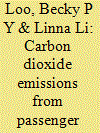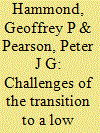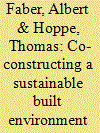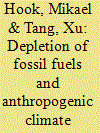|
|
|
Sort Order |
|
|
|
Items / Page
|
|
|
|
|
|
|
| Srl | Item |
| 1 |
ID:
116743


|
|
|
|
|
| Publication |
2012.
|
| Summary/Abstract |
A dominant resistance factor against wind power projects seems to be their visual impact on the landscape. In addition stress effects from aircraft obstruction markings are an emerging topic related to acceptance. As the height of wind turbines increases, so does the number of mandatory obstruction markings. Recently, obstruction markings have caused a growing number of complaints from residents. Whether obstruction markings indeed cause stress or even substantial annoyance remains an open question. To analyse the stress impact of obstruction markings, we used environmental and stress psychology methodologies. Residents (N=420) with direct sight of turbines at 13 wind farms participated in a questionnaire survey. Evidence of substantial annoyance caused by obstruction markings was not found. However, residents exposed to xenon lights reported more intense and multifaceted stress responses than exposed to LED or colour markings on blades. Moreover, xenon lights negatively affected the general acceptance of wind energy. Additionally, synchronised navigation lights were found to be less annoying than non-synchronised lights under certain weather conditions. Markings with light intensity adjustment proved to be advantageous. To reduce stress and increase social acceptance of wind power, xenon lights should be abandoned, navigation lights synchronised, and light intensity adjustment applied.
|
|
|
|
|
|
|
|
|
|
|
|
|
|
|
|
| 2 |
ID:
117247


|
|
|
|
|
| Publication |
2013.
|
| Summary/Abstract |
Industrial sector growth in developing countries requires the provision of alternatives to guarantee sustainable development. Improving energy efficiency and fuel switching are two measures to reduce CO2 emissions in the industrial sector, with natural gas and low-carbon electricity as the most feasible options in the short term. In this work, a linear programming optimization model has been developed to study the potential of energy efficiency improvement and fuel substitution for CO2 emissions reduction, at national level in the non-ferrous metals industry. The energy resource/end-use device allocation problem in secondary metal production and semi-fabrication has been modeled. Using this model, the particular case of Colombia, where low-carbon electricity is available, has been studied. By improving energy efficiency, energy use and CO2 emissions can be reduced significantly, 73% and 72%, respectively, at negative costs. Further CO2 emissions reductions, up to 88%, are possible with fuel switching to low-carbon electricity, increasing the costs for the energy system; however, cost reductions caused by energy efficiency improvement outweigh cost increments of fuel switching. Benefits achieved with fuel substitution using low-carbon electricity can be lost if hydropower is not available; in such a case, efficient natural gas-fired end-use devices are preferable.
|
|
|
|
|
|
|
|
|
|
|
|
|
|
|
|
| 3 |
ID:
117244


|
|
|
|
|
| Publication |
2013.
|
| Summary/Abstract |
This paper analyzes the energy, environmental and economic influences of three electricity scenarios in Korea by 2050 using the "Long-range Energy Alternatives Planning system" (LEAP) model. The reference year was 2008. Scenarios include the baseline (BL), new governmental policy (GP) and sustainable society (SS) scenarios. The growth rate of electricity demand in the GP scenario was higher than that of the BL scenario while the growth rate in the SS scenario was lower than that of the BL scenario.
Greenhouse gas emissions from electricity generation in 2050 in the BL and GP scenarios were similar with current emissions. However, emissions in 2050 in the SS scenario were about 80% lower than emissions in 2008, because of the expansion of renewable electricity in spite of the phase-out of nuclear energy.
While nuclear and coal-fired power plants accounted for most of the electricity generated in the BL and GP scenarios in 2050, the SS scenario projected that renewable energy would generate the most electricity in 2050. It was found that the discounted cumulative costs from 2009 to 2050 in the SS scenario would be 20 and 10% higher than that of the BL and GP scenarios, respectively.
|
|
|
|
|
|
|
|
|
|
|
|
|
|
|
|
| 4 |
ID:
117266


|
|
|
|
|
| Publication |
2013.
|
| Summary/Abstract |
The clean development mechanism (CDM) is a global collaborative action proposed at the Kyoto Protocol in response to climate change issues. The CDM contributes to cost-efficient reduction of greenhouse gas emissions in industrialized countries and promotes sustainable development in developing countries. Its fundamental framework is based on partnerships between industrialized and developing countries. This study employs social network analysis to investigate the dynamics of the partnership networks observed in 3816 CDM projects registered in the database of the United Nations Framework Convention on Climate Change over the period of 2005 to 2011. Our three main findings can be summarized as follows. First, the CDM partnership network is a small world; however, its density tends to decrease as the number of participants for a CDM project decreases. Second, the partnership networks' leading groups tend to shift from partner countries into host countries. Third, a host country that pursues more partnership-based projects takes better control of resources and knowledge-flow in the ego-network formed around that country, and can thus better utilize global resources for its CDM projects.
|
|
|
|
|
|
|
|
|
|
|
|
|
|
|
|
| 5 |
ID:
117261


|
|
|
|
|
| Publication |
2013.
|
| Summary/Abstract |
The power crisis problem is getting worse in the developing countries. Measures are being taken to overcome the power shortage problem by efficiently utilizing the available power. Replacement of high-power consumption lamps with energy efficient lamps is also among these steps. This paper presents a detailed comparative analysis between domestic lighting lamps (DLLs) use for producing artificial light. DLLs include incandescent lamp (IL), fluorescent lamp (FL) and compact fluorescent lamp (CFL). Light emitting diodes (LED) based lamp technology is relatively new in comparison with conventional incandescent and discharge lamps. However, the present study will also cover the LED lamps. Power quality based experiments have been conducted on DLLs in Power System Laboratory and power consumption based calculations are carried out using the lighting design software DIALux. The result shows that with the current technology, the use of FL and LED lamp is beneficial for utility as well as for consumer. However, with the current pace in the development of LED technology, it is possible LED lamps will lead the lighting market in the near future. The paper has also presented the uncertainties that exist in lighting market and proposed the guidelines that will help in making future energy policy.
|
|
|
|
|
|
|
|
|
|
|
|
|
|
|
|
| 6 |
ID:
117252


|
|
|
|
|
| Publication |
2013.
|
| Summary/Abstract |
In the last two decades, feed-in tariffs (FIT) have emerged as one of the most popular policies for supporting renewable electricity (RES-E) generation. A few studies have assessed the effectiveness of RES-E policies, but most ignore policy design features and market characteristics (e.g. electricity price and production cost) that influence policy strength. We employ 1992-2008 panel data to conduct the first econometric analysis of the effectiveness of FIT policies in promoting solar photovoltaic (PV) and onshore wind power development in 26 European Union countries. We develop a new indicator for FIT strength that captures variability in tariff size, contract duration, digression rate, and electricity price and production cost to estimate the resulting return on investment. We regress this indicator on added RES-E capacity using a fixed effects specification and find that FIT policies have driven solar PV development in the EU. However, this effect is overstated without controlling for country characteristics and is concealed without accounting for policy design. We do not find robust evidence that FIT policies have driven wind power development. Overall, we show that the interaction of policy design, electricity price, and electricity production cost is a more important determinant of RES-E development than policy enactment alone.
|
|
|
|
|
|
|
|
|
|
|
|
|
|
|
|
| 7 |
ID:
117232


|
|
|
|
|
| Publication |
2013.
|
| Summary/Abstract |
This paper describes initial analysis of branching points on a set of transition pathways to a UK low carbon electricity future by 2050. As described in other papers in this special issue, we are exploring and analysing a set of core transition pathways, based on alternative governance patterns in which the 'logics' of market actors, government actors and civil society actors, respectively dominate. This core pathway analysis is enhanced by analyses of branching points within and across the pathways, which informs how competition between different logics plays out at key decision points. Branching points are defined as key decision points at which choices made by actors, in response to internal or external stresses or triggers, determine whether and in what ways the pathway is followed. A set of initial branching points for our three core transition pathways is identified through project and stakeholder workshops, and drawing on analysis of actors' choices and responses at past branching points in energy system transitions. The potential responses of the actors are identified at these branching points, and risk mitigation strategies are formulated for the dominant actors to reinforce that pathway, as well as opportunities for actors to move away from the pathway.
|
|
|
|
|
|
|
|
|
|
|
|
|
|
|
|
| 8 |
ID:
116731


|
|
|
|
|
| Publication |
2012.
|
| Summary/Abstract |
This paper traces the historical evolution and spatial disparity of CO2 emissions from passenger transport in China. The general trends of CO2 emissions from four passenger transport modes are estimated by both the distance-based and fuel-based methods. The results suggest that CO2 emissions from road transport represented the leading source of passenger transport CO2 emissions in China. Moreover, they have continued to grow rapidly. Air transport was the second largest contributor since 1998. Emissions from rail and water transport have remained relatively stable with lower emission intensity. At the provincial level, great regional disparity was noticeable, especially in road transport. Moreover, the decomposition analysis shows that income growth was the principal factor leading to the growth of passenger transport CO2 emissions in China for both the 1949-1979 and 1980-2009 periods. The second most important factor was increased transport intensity and modal shifts for the former and the latter period, respectively. The main factor contributed to emission reduction was the lower emission intensity supported by policies, although the effect was weak. In the future, more policies to encourage modal shifts toward sustainable transport modes and travel reduction should be encouraged.
|
|
|
|
|
|
|
|
|
|
|
|
|
|
|
|
| 9 |
ID:
117220


|
|
|
|
|
| Publication |
2013.
|
| Summary/Abstract |
Electricity generation presently contributes approximately 30% of United Kingdom (UK) carbon dioxide (CO2) emissions (Alderson et al., 2012 and Parliamentary, 2007), the principal 'greenhouse gas' (GHG) having an atmospheric residence time of about 100 years (Hammond, 2000). This share mainly arises from the use of fossil fuel (coal and natural gas) combustion for this purpose. Changes in atmospheric concentrations of GHGs affect the energy balance of the global climate system. Human activities have led to quite dramatic increases since 1950 in the 'basket' of GHGs incorporated in the Kyoto Protocol; concentrations have risen from 330 ppm to about 430 ppm currently (IPCC, 2007). Prior to the first industrial revolution in the 18th Century the atmospheric concentration of 'Kyoto gases' was only some 270 ppm. The cause of the observed rise in global average near-surface temperatures over the second half of the 20th Century has been a matter of dispute and controversy. But the most recent (2007) scientific assessment by the Intergovernmental Panel on Climate Change (IPCC) states with 'very high confidence' that humans are having a significant impact on the global warming (IPCC, 2007). They argue that GHG emissions from human activities trap long-wave thermal radiation from the Earth's surface in the atmosphere (not strictly 'greenhouse' phenomena), and that these are the main cause of rises in climatic temperatures. In order to mitigate anthropogenic climate change, the Royal Commission on Environmental Pollution in the UK (RCEP, 2000) recommended at the turn of the Millennium a 60% cut in UK CO2 emissions by 2050. The British Government subsequently set a tougher, legally binding target of reducing the nation's CO2 emissions overall by 80% by 2050 in comparison to a 1990 baseline ( Department of Trade and Industry [DTI], 2007 and Climate, 2008).
|
|
|
|
|
|
|
|
|
|
|
|
|
|
|
|
| 10 |
ID:
117240


|
|
|
|
|
| Publication |
2013.
|
| Summary/Abstract |
This paper provides an ex-post assessment of the climate and energy policy developments in Chile emerging from a neoliberal economic model, during the period 1971-2007. First, correlation and regression analyses were performed to analyse historical CO2 emissions as a product of demographic, economic and energy-wide drivers. Then I estimate indicators related to CO2 emissions, energy use and economic activity. In the light of empirical results, I identify policy instruments and structural issues. Finally, I present a comparative analysis of Chile and other Latin American countries. Statistical tests show that variability of CO2 emissions is explained mostly by GDP per capita ('affluence') than any other tested variable. Indicators show that the diversification and decarbonisation of the energy mix has been a major policy challenge. With two notable exceptions (hydro and natural gas), the CO2 intensity of the energy supply mix suggests no effective policies, while energy security crises triggered negative carbon effects and increased prices. No clear policies to promote energy efficiency can be identified until 2005. Explicit policy instruments to promote renewable energy are only recognised after 2004. The results strongly suggest that Chile lacked of policies to effectively decarbonise its energy-economy system.
|
|
|
|
|
|
|
|
|
|
|
|
|
|
|
|
| 11 |
ID:
117275


|
|
|
|
|
| Publication |
2013.
|
| Summary/Abstract |
There is considerable scope for energy efficiency improvements to the housing stock in the Netherlands. Although, economically, there are many technological opportunities available, the Dutch built environment has difficulty to harvest this potential. This paper applies a sectoral innovation system approach to investigate this apparent paradox. This approach allows to identify and assess systemic barriers that prevent improvement in overall energy efficiency of the Dutch housing sector. Twenty-one experts were interviewed, and a qualitative data analysis was applied to identify barriers, and relate them to key dimensions in the sectoral innovation system framework. From this analysis, we identified poor regulatory design, lack of market demand, and some institutional characteristics of the construction sector as the key systemic barriers that hamper the diffusion of green energy innovations in the Dutch housing sector.
|
|
|
|
|
|
|
|
|
|
|
|
|
|
|
|
| 12 |
ID:
117290


|
|
|
|
|
| Publication |
2013.
|
| Summary/Abstract |
Ancillary services are required to maintain the unity, stability, and quality of power systems. In Colombia these services are required to operate the national power system and the international connections with the neighboring countries. The system is influenced by factors ranging from system's topology to social and political aspects, such as the large number of terrorist attacks. In light of these particularities, we consider Colombia as a learning lab for ancillary services in the region. Colombia's power system relies on three ancillary services for its operation, namely frequency regulation, voltage control, and blackstart service. From 2010 Special Protection Systems were also added. In this paper we first analyze the technical aspects, operational restrictions, financial management, and the most relevant regulatory conditions of these ancillary services of the SIN. We also take into consideration the main regulatory characteristics and statistical data related to energy exchanges that have taken place between Colombia and Venezuela and Ecuador. Thereafter, we depict the main weaknesses and policy challenges that Colombia must address in order to increase the effectiveness and coverage of ancillary services in both the SIN and in the international interconnections. Finally, we propose new market oriented regulations to encourage investments and new tools for international connections.
|
|
|
|
|
|
|
|
|
|
|
|
|
|
|
|
| 13 |
ID:
117257


|
|
|
|
|
| Publication |
2013.
|
| Summary/Abstract |
Consumers and organizations worldwide are searching for low-carbon alternatives to conventional gasoline and diesel vehicles to reduce greenhouse gas (GHG) emissions and their impact on the environment. A comprehensive technique used to estimate overall cost and environmental impact of vehicles is known as life cycle assessment (LCA). In this article, a comparative LCA of diesel and compressed natural gas (CNG) powered heavy duty refuse collection vehicles (RCVs) is conducted. The analysis utilizes real-time operational data obtained from the City of Surrey in British Columbia, Canada. The impact of the two alternative vehicles is assessed from various points in their life. No net gain in energy use is found when a diesel powered RCV is replaced by a CNG powered RCV. However, significant reductions (approximately 24% CO2-equivalent) in GHG and criteria air contaminant (CAC) emissions are obtained. Moreover, fuel cost estimations based on 2011 price levels and a 5-year lifetime for both RCVs reveal that considerable cost savings may be achieved by switching to CNG vehicles. Thus, CNG RCVs are not only favorable in terms of reduced climate change impact but also cost effective compared to conventional diesel RCVs, and provide a viable and realistic near-term strategy for cities and municipalities to reduce GHG emissions.
|
|
|
|
|
|
|
|
|
|
|
|
|
|
|
|
| 14 |
ID:
117294


|
|
|
|
|
| Publication |
2013.
|
| Summary/Abstract |
The road transport sector today is almost exclusively dependent on fossil fuels. Consequently, it will need to face a radical change if it aims to switch from a fossil-based system to a renewable-based system. Even though there are many promising technologies under development, they must also be economically viable to be implemented. This paper studies the economic feasibility of synthesizing natural gas through methanation of carbon dioxide and hydrogen from water electrolysis. It is shown that the main influences for profitability are electricity prices, synthetic natural gas (SNG) selling prices and that the by-products from the process are sold. The base scenario generates a 16% annual return on investment assuming that SNG can be sold at the same price as petrol. A general number based on set conditions was that the SNG must be sold at a price about 2.6 times higher per kWh than when bought in form of electricity. The sensitivity analysis indicates that the running costs weigh more heavily than the yearly investment cost and off-peak production can therefore still be economically profitable with only a moderate reduction of electricity price. The calculations and prices are based on Swedish prerequisites but are applicable to other countries and regions.
|
|
|
|
|
|
|
|
|
|
|
|
|
|
|
|
| 15 |
ID:
117255


|
|
|
|
|
| Publication |
2013.
|
| Summary/Abstract |
Federal electric vehicle (EV) policies in the United States currently include vehicle purchase subsidies linked to EV battery capacity and subsidies for installing charging stations. We assess the cost-effectiveness of increased battery capacity vs. nondomestic charging infrastructure installation for plug-in hybrid electric vehicles as alternate methods to reduce gasoline consumption for cars, trucks, and SUVs in the US. We find across a wide range of scenarios that the least-cost solution is for more drivers to switch to low-capacity plug-in hybrid electric vehicles (short electric range with gasoline backup for long trips) or gasoline-powered hybrid electric vehicles. If more gasoline savings are needed per vehicle, nondomestic charging infrastructure installation is substantially more expensive than increased battery capacity per gallon saved, and both approaches have higher costs than US oil premium estimates. Cost effectiveness of all subsidies are lower under a binding fuel economy standard. Comparison of results to the structure of current federal subsidies shows that policy is not aligned with fuel savings potential, and we discuss issues and alternatives
|
|
|
|
|
|
|
|
|
|
|
|
|
|
|
|
| 16 |
ID:
117233


|
|
|
|
|
| Publication |
2013.
|
| Summary/Abstract |
Electricity generation in China mainly depends on coal and its products, which has led to the increase in CO2 emissions. This paper intends to analyze the current status of CO2 emissions from electricity generation in China during the period 1991-2009, and apply the logarithmic mean Divisia index (LMDI) technique to find the nature of the factors influencing the changes in CO2 emissions. The main results as follows: (1) CO2 emission from electricity generation has increased from 530.96 Mt in 1991 to 2393.02 Mt in 2009, following an annual growth rate of 8.72%. Coal products is the main fuel type for thermal power generation, which accounts for more than 90% CO2 emissions from electricity generation. (2) This paper also presents CO2 emissions factor of electricity consumption, which help calculate CO2 emission from final electricity consumption. (3) In China, the economic activity effect is the most important contributor to increase CO2 emissions from electricity generation, but the electricity generation efficiency effect plays the dominant role in decreasing CO2 emissions.
|
|
|
|
|
|
|
|
|
|
|
|
|
|
|
|
| 17 |
ID:
117224


|
|
|
|
|
| Publication |
2013.
|
| Summary/Abstract |
The energy system can only be considered sustainable in the long term if it is low carbon, affordable and secure. These three create a complex trilemma for all stakeholders in the energy business who have to strike a careful balance without neglecting any one aspect. This discussion paper examines the issues surrounding security of supply of the power system which has received less attention than the other aspects. It looks at how threats and mitigation measures can be classified in terms of where they act on the supply chain and the timescale over which they act. Only by considering the full range of timescales from seconds to decades can the full picture emerge of the effects of new technologies on security of supply. An examination of blackouts over the past 40 years sheds light on the causes of failure to supply and the most vulnerable aspects of the supply chain.
|
|
|
|
|
|
|
|
|
|
|
|
|
|
|
|
| 18 |
ID:
117293


|
|
|
|
|
| Publication |
2013.
|
| Summary/Abstract |
Future scenarios with significant anthropogenic climate change also display large increases in world production of fossil fuels, the principal CO2 emission source. Meanwhile, fossil fuel depletion has also been identified as a future challenge. This chapter reviews the connection between these two issues and concludes that limits to availability of fossil fuels will set a limit for mankind's ability to affect the climate. However, this limit is unclear as various studies have reached quite different conclusions regarding future atmospheric CO2 concentrations caused by fossil fuel limitations.
It is concluded that the current set of emission scenarios used by the IPCC and others is perforated by optimistic expectations on future fossil fuel production that are improbable or even unrealistic. The current situation, where climate models largely rely on emission scenarios detached from the reality of supply and its inherent problems are problematic. In fact, it may even mislead planners and politicians into making decisions that mitigate one problem but make the other one worse. It is important to understand that the fossil energy problem and the anthropogenic climate change problem are tightly connected and need to be treated as two interwoven challenges necessitating a holistic solution.
|
|
|
|
|
|
|
|
|
|
|
|
|
|
|
|
| 19 |
ID:
117249


|
|
|
|
|
| Publication |
2013.
|
| Summary/Abstract |
It is difficult to control household energy consumption through regulation. From a policy standpoint, it is particularly challenging to identify the factors that influence people's actions. Moreover, whatever these factors are, they are unlikely to uniformly span multiple cities in the Asian region. In this paper, we conduct a survey of energy-saving behavior to clarify the differences among such factors across five major Asian cities. The results from these surveys in Dalian, Chongqing, Fukuoka, Bangkok, and Ho Chi Minh indicate that global warming consciousness, environmental behavior, and social interaction significantly affect energy-saving behavior. Income and age also had weak positive effects on energy-saving behaviors. Social interaction was strongly linked to energy-saving behaviors, particularly in the rural areas of Dalian and Chongqing. This result indicates that community-based activities impact energy-saving behaviors.
|
|
|
|
|
|
|
|
|
|
|
|
|
|
|
|
| 20 |
ID:
116715


|
|
|
|
|
| Publication |
2012.
|
| Summary/Abstract |
This paper reviews the thermal performance of the existing UK housing stock, the main fabric efficiency incentive schemes and the barriers to obtaining deep energy and CO2 savings throughout the stock. The UK faces a major challenge to improve the thermal performance of its existing housing stock. Millions of dwellings possess 'hard-to-treat' solid walls and have glazing which is not cost effective to improve. A range of fabric efficiency incentive schemes exist, but many do not target the full range of private and social housing. From now on, the Green Deal will be the UK's key energy efficiency policy. However, the scheme is forecasted to have low consumer appeal and low incentives for investors. Moreover, calculated Green Deal loan repayments will be reliant upon estimated energy savings, yet it is claimed that retrofit measures may only be half as effective as anticipated due to a lack of monitoring, poor quality installation and the increased use of heating following refurbishment. Looking to Germany, there has been success through the Passivhaus standard, but the UK currently lacks appropriate skills and cost effective components to replicate this approach. In addition, the embodied energy in retrofit products and materials threatens to counter operational savings.
|
|
|
|
|
|
|
|
|
|
|
|
|
|
|
|
|
|
|
|
|